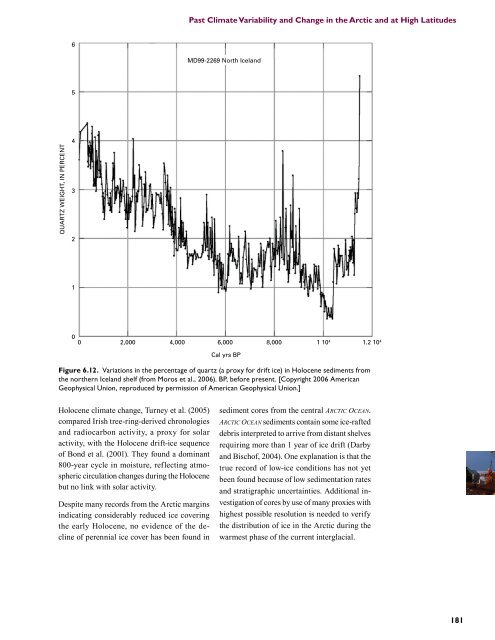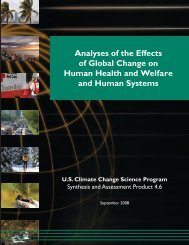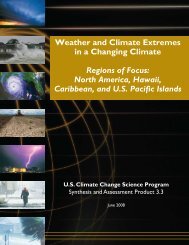Past Climate Variability and Change in the Arctic and at High Latitudes
Past Climate Variability and Change in the Arctic and at High Latitudes
Past Climate Variability and Change in the Arctic and at High Latitudes
You also want an ePaper? Increase the reach of your titles
YUMPU automatically turns print PDFs into web optimized ePapers that Google loves.
QUARTZ WEIGHT, IN PERCENT<br />
6<br />
5<br />
4<br />
3<br />
2<br />
1<br />
0 0 2,000 4,000 6,000<br />
<strong>Past</strong> <strong>Clim<strong>at</strong>e</strong> <strong>Variability</strong> <strong>and</strong> <strong>Change</strong> <strong>in</strong> <strong>the</strong> <strong>Arctic</strong> <strong>and</strong> <strong>at</strong> <strong>High</strong> L<strong>at</strong>itudes<br />
MD99-2269 North Icel<strong>and</strong><br />
Cal yrs BP<br />
8,000 1 10 4 1.2 10 4<br />
Figure 6.12. Vari<strong>at</strong>ions <strong>in</strong> <strong>the</strong> percentage of quartz (a proxy for drift ice) <strong>in</strong> Holocene sediments from<br />
<strong>the</strong> nor<strong>the</strong>rn Icel<strong>and</strong> shelf (from Moros et al., 2006). BP, before present. [Copyright 2006 American<br />
Geophysical Union, reproduced by permission of American Geophysical Union.]<br />
Holocene clim<strong>at</strong>e change, Turney et al. (2005)<br />
compared Irish tree-r<strong>in</strong>g-derived chronologies<br />
<strong>and</strong> radiocarbon activity, a proxy for solar<br />
activity, with <strong>the</strong> Holocene drift-ice sequence<br />
of Bond et al. (2001). They found a dom<strong>in</strong>ant<br />
800-year cycle <strong>in</strong> moisture, reflect<strong>in</strong>g <strong>at</strong>mospheric<br />
circul<strong>at</strong>ion changes dur<strong>in</strong>g <strong>the</strong> Holocene<br />
but no l<strong>in</strong>k with solar activity.<br />
Despite many records from <strong>the</strong> <strong>Arctic</strong> marg<strong>in</strong>s<br />
<strong>in</strong>dic<strong>at</strong><strong>in</strong>g considerably reduced ice cover<strong>in</strong>g<br />
<strong>the</strong> early Holocene, no evidence of <strong>the</strong> decl<strong>in</strong>e<br />
of perennial ice cover has been found <strong>in</strong><br />
sediment cores from <strong>the</strong> central <strong>Arctic</strong> oceAn.<br />
<strong>Arctic</strong> oceAn sediments conta<strong>in</strong> some ice-rafted<br />
debris <strong>in</strong>terpreted to arrive from distant shelves<br />
requir<strong>in</strong>g more than 1 year of ice drift (Darby<br />
<strong>and</strong> Bischof, 2004). One explan<strong>at</strong>ion is th<strong>at</strong> <strong>the</strong><br />
true record of low-ice conditions has not yet<br />
been found because of low sediment<strong>at</strong>ion r<strong>at</strong>es<br />
<strong>and</strong> str<strong>at</strong>igraphic uncerta<strong>in</strong>ties. Additional <strong>in</strong>vestig<strong>at</strong>ion<br />
of cores by use of many proxies with<br />
highest possible resolution is needed to verify<br />
<strong>the</strong> distribution of ice <strong>in</strong> <strong>the</strong> <strong>Arctic</strong> dur<strong>in</strong>g <strong>the</strong><br />
warmest phase of <strong>the</strong> current <strong>in</strong>terglacial.<br />
181




